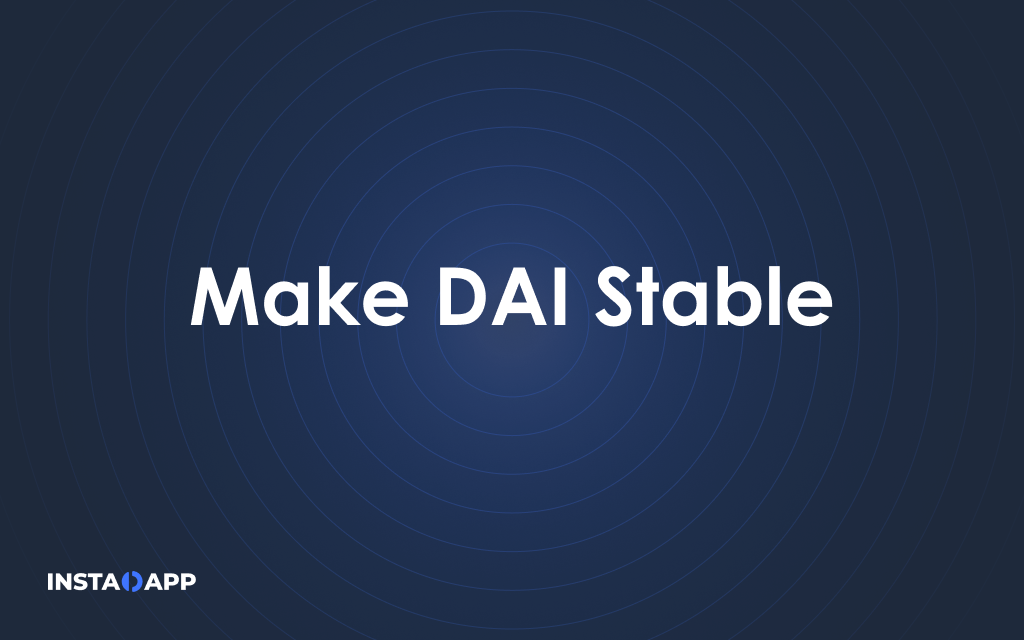Make DAI Stable
Opportunities to stabilize DAI

MakerDAO plays a crucial role in DeFi with DAI being used as a backbone of the overall DeFi ecosystem, so it becomes crucial to make DAI more stable.
We, at Instadapp, proactively look for the problems in the ecosystem and spend considerable time and efforts to find the best solution.

DAI gets unstable due to an imbalance in the supply/demand whenever ETH price hugely crashes or spikes. MakerDAO governance changes the DAI borrowing & saving rates to increase the inflow or outflow of DAI in the market according to the needs.
But YET, most of the time, it takes a bit for DAI to get back to $1 due to high friction for users to access DeFi, lack of efficient interoperability and lack of knowledge to end-user. In this article I'll cover a few solutions which can provide huge stability to DAI instantly.
We are making these solutions live on our dapp in the coming weeks BUT the developers can create models with the arbitrage opportunities to help users earn money, while making DAI more stable in the process. Go through our docs, and especially check out the use-cases!
MakerDAO Governance
- When DAI > $1, governance decides to reduce the borrow and savings rates (sometimes even 0%), which economically results in users minting more DAI and suppliers to withdraw their DAI from DSR to look for better returns. This results in increased DAI supply in the market, making DAI stable.
- When DAI < $1, governance decides to increase the borrow and savings rates (sometimes even to 20%), which economically results in users paying DAI debt and lenders to supply more DAI for better returns. This results in decreased DAI supply in the market, making DAI stable.
When DAI supply is less than the demand, DAI price is more than $1 & when DAI supply is more than demand, DAI price is less than $1. Interoperability between protocols and optimization of assets could result in the equilibrium of the demand and supply.
The following are the few primary solutions.
Lending Optimization
DAI > $1: The Compound DAI utilization increases (sometimes even reaches to ~100%) because of excess in demand of DAI, which results in higher interest and lack of DAI to borrow. The user gets incentivized to move lending from Maker's DSR to Compound, which also helps Compound's DAI utilization to go down.

You can find the code to implement this on our docs - (check this use-case).
Debt Optimization
DAI > $1: The Compound DAI utilization increases (sometimes reaches ~100%) because of excess in demand of DAI, which results in higher interest. The user gets incentivized to move their Compound DAI debt position into Maker's Vault, which results in the minting of new DAI and helps Compound's DAI utilization to go down.
DAI < $1: The Compound DAI utilization decreases because of a lack of DAI demand, which results in lower interest rates. The user gets incentivized to move their Maker Vault position into Compound DAI debt, which results in the burning of DAI and helps Compound's DAI utilization to go up.

You can find the code to implement this on our docs (check this use-case).
Debt Swap
DAI > $1: Swap USDC debt into DAI debt at a discounted price by borrowing DAI, swap with USDC, and payback USDC debt. Let's assume DAI is $1.02; now, when you swap 10000 DAI into USDC, you'll get 10200 USDC, which is a 2% instant discount on debt and increases DAI supply in the market making DAI stable.
DAI < $1: Swap DAI debt into USDC debt at a discounted price by borrowing USDC, swap with DAI, and payback DAI debt. Let's assume DAI is $0.98; now, when you swap 10000 USDC into DAI, you'll get 10204 DAI results in ~2% discount on debt and decreases DAI supply in the market making DAI stable.

You can find the code to implement this on our docs (check this use-case).
Short and long DAI
DAI > $1: Go short on DAI using USDC as collateral (use either USDC vault or compound position). Let's assume DAI is $1.02. Now, if you go 4x short using USDC Vault with 10000 USDC as a base starting point, you'll end up with a 40600 USDC vault with 30000 DAI debt. That's an instant $600 and increasing DAI supply, making DAI stable.

DAI < $1: Go Long on DAI (short on USDC) using DAI as collateral on Compound. Let's assume DAI is $0.98. Now, if you go 4x long using 10000 DAI as a base starting point, you'll end up with 40612 DAI with 30000 USDC debt. That's $612 and resulting in a decrease of DAI supply, making DAI stable.

You can find the code to implement this on our docs (check this use-case).
Lets talk DApps!
And also, keep an eye out on our next announcements. We are making these solutions live on our dapp, but feel free to go through our docs to start implementing those use-cases by yourself.
We're all ears and would like to invite everyone to join us on Discord, Twitter or email.
Written by Samyak Jain
